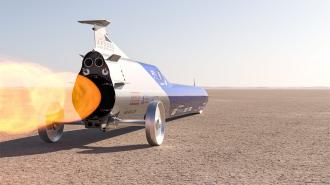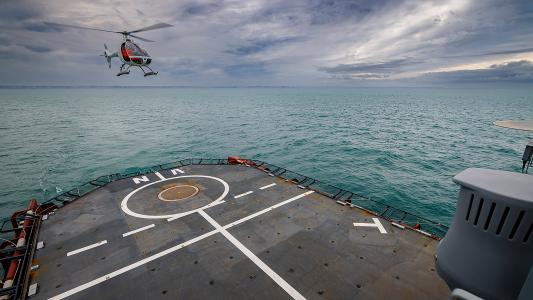On the morning of October 15, 1997, the quiet of Nevada’s Black Rock Desert was pierced by a sonic boom that echoed across the landscape like an enormous cannon shot.
The sound’s origin came not from the sky — where pilot Chuck Yeager first broke the sound barrier almost exactly 50 years before — but from the ground, where a black, 10-ton vehicle resembling a missile streaked across the horizon, trailed by a cloud of white exhaust and brown dust.
The Thrust SuperSonic Car (ThrustSSC) — a 54-foot long, 12-foot-wide jet car powered by two Rolls-Royce Spey engines commonly used in fighter jets — had just become the world’s first supersonic land vehicle. With British Royal Air Force pilot Andy Green at the controls, the car set an absolute land speed record (LSR) of 763.035 mph.
Over a quarter of a century later, in a world that seems to be constantly pushing through scientific and engineering boundaries, the record has yet to be broken. Why?
The Ground History
In May 1893, steam locomotive engine 999 — of New York Central’s Empire State Express — set a LSR of 112.5 mph during a one-mile section of its 40-mile journey from Batavia to Buffalo. Engine 999 is widely considered to be the first man-made vehicle to exceed 100 mph.
Records for automobiles began being kept several years later, but different organizations didn’t always recognize the same records. Generally, though, these records were recorded over a one-kilometer distance (0.62 miles).
In 1898, Gaston de Chasseloup-Laubat drove a French-made electric car to just over 39 mph, setting a record that was to be continuously built upon. By 1904, the 100-mph automobile barrier was broken by Frenchman Louis Rigolly.
Eventually, standards became more refined: for official records, two passes — made within one hour of each other in opposite directions (to factor wind) — are averaged, with new records needing to be more than 1% faster than an old record to count.
The 200-mph barrier fell in 1927 — courtesy of Britton Henry Segrave — on the sands of Daytona Beach, Florida, where many LSRs have been set or attempted. Malcolm Campbell broke the 300-mph barrier in 1935 at Utah’s Bonneville Salt Flats, another legendary place of speed records.
In July 1964, Donald Campbell’s Bluebird CN7 set a mile speed of 403 mph, which was the last time the LSR was set by a wheel-powered vehicle. Craig Breedlove had actually gone even faster the year prior in his three-wheeled Spirit of America jet car, but regulations of the era made it unofficial for a time.
Rules established in 1964 made the absolute LSR the highest speed recorded by any vehicle on wheels, regardless of how they were powered — meaning jet cars were officially in. Breedlove broke 500 mph that October and 600 mph in 1965. In 1983, Richard Noble took Thrust2 to 633.47 mph, a mark not broken for 13 years, until Green’s ThrustSSC hit 714.144 mph in September 1997.
The following month, the all-time record was set, where it has stood ever since.
Failures and the Future
Since ThrustSSC’s record-breaking trip in 1997, challengers have appeared.
In 2006, adventurer Steve Fossett bought Breedlove’s Spirit of America with designs on the record, but his 2007 death in a plane crash ended the pursuit before it was truly started.
From 1999 to 2019, the North American Eagle Project — a team of Canadian and U.S. volunteers led by former IBM engineer Ed Shadle — had serious aspirations to break the record.
Their vehicle, a Lockheed F-104 Starfighter modified to remain land-bound, did go fast: Shadle hit 400 mph in a 2008 test run in the Mojave Desert, and when former Mythbusters host Jessi Combs was added as a pilot, the North American Eagle flew even faster.
If funding falls into place, the next great human engineering endeavor may be just two miles from reality.
But in August 2019, the 39-year-old Combs was tragically killed while setting a women’s world land speed record in Oregon’s Alvord Desert. She took the Eagle to its fastest speed ever on her final run: 522.783 mph, officially breaking a more than 45-year-old women’s record. Sadly, Shadle had also died of cancer the year before, and after Combs’ death, the project was abandoned for good.
The inability to find major funding hampered the progress of North American Eagle, and that problem has also dogged the two current LSR efforts.
Aussie Invader, a program led by Australian pilot Rosco McGlashan (who once went 253 mph in a rocket-powered go-kart), is an attempt to set a 1,000-mph LSR.
McGlashan has been pursuing the record since the 1990s, achieving a top speed of 638 mph in his Aussie Invader 3 machine in 2000. The current ride, Aussie Invader 5R, has been under construction and refining since 2009. It’s immensely powerful, emitting 62,000 pounds of thrust from two rocket engines estimated to produce over 200,000 horsepower.
Meanwhile, in the United Kingdom, the Bloodhound LSR program is also hoping to be the first to set new LSRs and eclipse 1,000 mph. The project has been under development since 2008, and the vehicle is being piloted by current record holder Andy Green. In addition to a Rolls-Royce jet engine, Bloodhound is relying on a rocket engine for additional boost and speed.
Bloodhound has seen several financial challenges hamper its goals: a 2018 bankruptcy led British entrepreneur Ian Warhurst to take over the project to keep it from being dismantled. Under Warhurst, Bloodhound went 628 mph in a November 2019 test run in South Africa’s Kalahari Desert.
But then the COVID-19 pandemic disrupted things, and the vehicle was moved to England’s Coventry Transport Museum in 2021 for safe keeping. That same year, the project’s engineering operations manager, Stuart Edmondson, took over as Bloodhound’s CEO. The program also supports Bloodhound Education Ltd, a registered charity that encourages STEM learning for school children, using their supercar, the pursuit of the land speed record, and related topics to teach children about engineering and science.
Edmondson told The Sunday Times’ Driving publication in 2022 that about $11 million in additional funding is needed to truly attempt their goals of 800 and then 1,000 mph.
Bloodhound is also looking at a more environmentally-conscious land speed record: one that is potentially carbon-neutral. A synthetic e-fuel, which Porsche is currently working on, would combine hydrogen and methanol in a liquid mixture.
Both the Aussie Invader and Bloodhound teams remain committed to eventually breaking the 1997 LSR. If funding falls into place, the next great human engineering endeavor may be just two miles from reality.
We’d love to hear from you! If you have a comment about this article or if you have a tip for a future Freethink story, please email us at [email protected].






